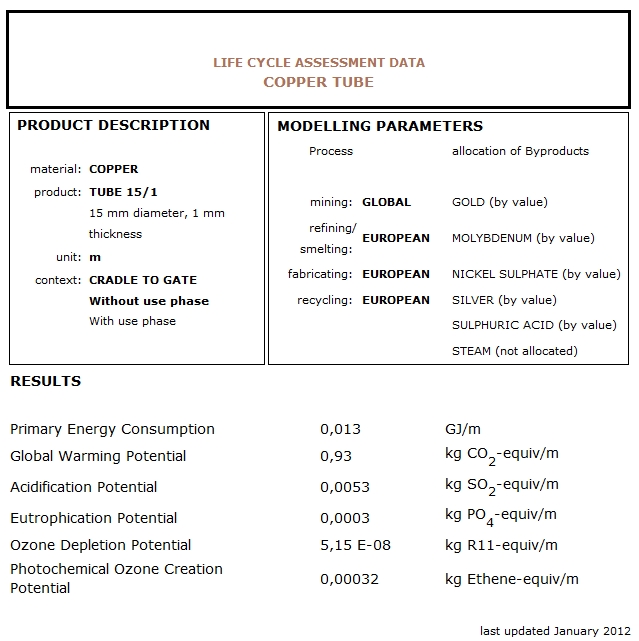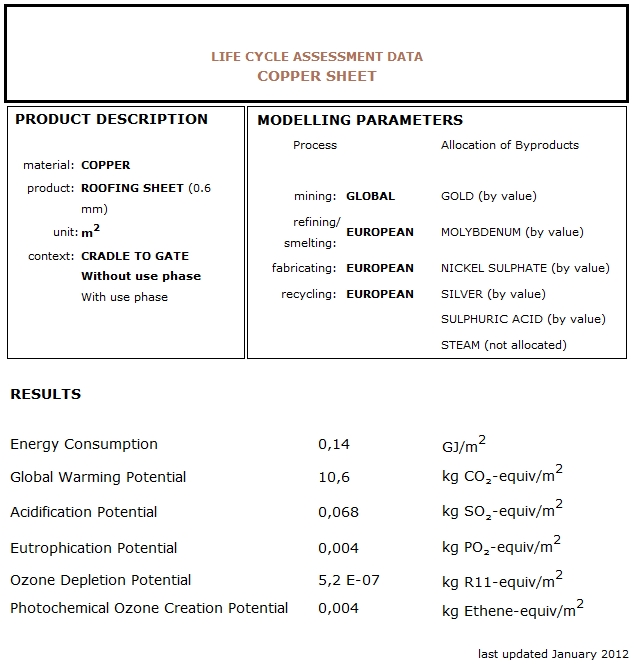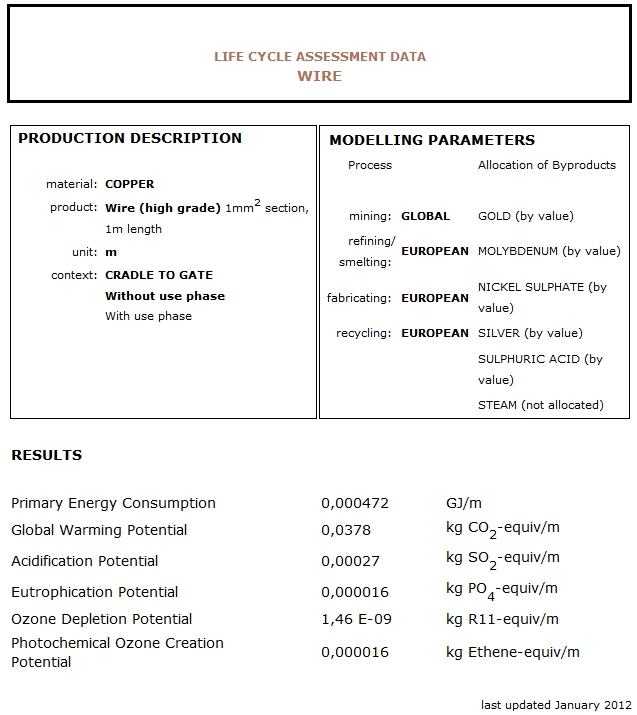
Life Cycle study of copper - Methodology
Life Cycle Assessment is a scientific tool to assess the environmental impacts of products. It is increasingly being used during the design phase to optimise across the initial production, the use phase and the end of life, reflecting disposal or recycling. For metals, a typical “cradle to grave” study covers the mining and extraction of raw materials, fabrication, transportation, use, and recycling/disposal, including energy and all other product supplies required.
ISO guidelines require the underlying life cycle inventories to have undergone independent peer review. From this initial concept, Life Cycle Assessment is now being used as a marketing and decision making tool to make comparisons between materials and products for similar end use applications. This use of the assessment of environmental sustainability as a comparison tool in order to select environmentally friendly products needs to be approached with some caution.
In such comparisons, detailed checks must be made to ensure that the system boundaries are comparable. In particular, this must be the case for the scope, the functional unit and the use phase. Life Cycle Assessment results strongly depend on the choice of material. Individual impacts (e.g. global warming, acidification, ozone depletion, etc.) do not have equivalent environmental effects. Only a comparison of identical impact categories leads to appropriate and meaningful statements. The aggregation of impacts to one single indicator should also be avoided when making comparative studies. A preferred approach to decision making is one that takes into account the importance of national or local priorities with regards to the different impact categories.
(Results as of January 2012)
Comparison of plumbing systems
In comparative studies on tubes for various plumbing systems, e.g. drinking water, heating and gas, it is misleading to simply consider the impact of 1 m of tube made from different materials. Plumbing systems are normally designed to transport specified volumes of fluids, with different tube diameters and wall thicknesses required dependent on the choice of material. In addition, consideration must be given to the different design practices, installation and jointing standards and regulatory requirements for each.
Many cradle to grave life cycle assessment studies have shown that the environmental aspects from the use and end of life phases of products are often much more significant, for example the lower losses from copper in hot water systems. The economic value of copper scrap, based on its ability to be recycled 100% without any loss in performance, must be included in comparative assessments.

Comparison of architectural materials
In comparing copper architectural sheets with other roofing and facade materials, any comparison by weight is not relevant. Life cycle assessments should be based on the functional unit, with a sheet thickness of 0.6 mm being the most commonly available in the market today for roofing. The use phase of copper roofing is also one of the longest, easily reaching well beyond 100 years. Copper church roofs still functional after more than 500 years are known.
The type of covering and the inclination of the roof should also be considered. One m² of sheet may not necessarily be equivalent to one m² of roof or one m² of building surface. The specific properties of each material, the underlying support structures and the design all need to be considered. Many cradle to grave life cycle assessment studies have shown that the environmental aspects from the use and end of life phases of products are often much more significant. The economic value of copper scrap, based on its ability to be recycled 100% without any loss in performance, must be included in comparative assessments.

Comparison of wire
With the exception of silver, copper has the highest electrical conductivity of all metals, approximately twice that of aluminium and six times that of iron. A material with a lower conductivity requires a larger cross section for the same current carrying capacity. Copper wiring is the standard in residential building wire and its use in transformers and motor driven systems helps to increase energy efficiency. In electrical applications, while the use phase is the most important in the overall life cycle assessment, the economic value of copper scrap, based on its ability to be recycled 100% without any loss in performance, must also be included in comparative assessments.
Given the broad range of wire diameters in use in the market, the data provided is for one metre of uninsulated copper wire, with a cross section of one square millimetre. The data values should be adjusted to fit the exact wire size for any given application. For example, a typical residential building wire has a cross section of 2.5 square millimetres.

Are you looking for a different content?
Life-Cycle-Center
The copper industry is a leader among industries committed to reducing the environmental impact of their operations.
More